Fertility Treatments: What Works and How to Choose
If you’ve been trying to conceive and nothing seems to move, you’re not alone. Millions face fertility challenges, and modern medicine offers many ways to help. Below is a no‑jargon guide to the main treatments, when to consider them, and tips to improve outcomes.
Medications and Simple Procedures
Most doctors start with medication because it’s the cheapest and easiest option. Clomiphene (Clomid) and letrozole stimulate ovulation in women who don’t release eggs regularly. Men might get hormone shots or pills to boost sperm count. These drugs are taken for a few cycles, and many couples see results quickly.
If ovulation drugs don’t work, the next step is usually intrauterine insemination (IUI). In IUI, sperm are washed, concentrated, and placed directly into the uterus during the fertile window. It’s a short office visit and costs far less than IVF.
Advanced Assisted Reproductive Technology
When simpler methods fall short, IVF (in‑vitro fertilization) becomes the go‑to. Eggs are retrieved, mixed with sperm in a lab, and the best embryos are transferred back into the uterus. Success rates vary—roughly 30‑45 % per cycle for women under 35, dropping with age.
Some clinics also offer ICSI (intracytoplasmic sperm injection) for severe male factor infertility, and pre‑implantation genetic testing (PGT) to screen embryos for genetic issues. These add cost but can improve the odds of a healthy pregnancy.Donor eggs or sperm, and gestational carriers, are options when a partner’s gametes aren’t viable. They involve legal contracts and higher expenses, so talk to a specialist about the pros and cons.
Beyond medical treatments, lifestyle tweaks matter. Maintaining a healthy weight, quitting smoking, limiting caffeine, and managing stress can boost fertility by up to 20 %. Eating a balanced diet rich in folate, omega‑3s, and antioxidants supports egg and sperm quality.
When should you see a specialist? If you’re under 35 and haven’t conceived after a year of regular, unprotected sex, or over 35 after six months, schedule an evaluation. A basic work‑up includes hormone testing, ultrasound, and semen analysis.
Costs can add up quickly. Medication cycles range from $100‑$500, IUI about $600‑$1,200 per attempt, and IVF often $12,000‑$20,000 per cycle. Many clinics offer financing, insurance coverage varies, and some states have mandates for fertility benefits.
Bottom line: Start low‑cost, discuss your goals with a reproductive endocrinologist, and be ready for a step‑by‑step plan. The right mix of medication, procedures, and lifestyle changes can turn a tough journey into a hopeful one.
Discover five viable alternatives to Clomid for fertility treatments in 2024. This guide explores options ranging from natural remedies like Black Cohosh to prescription medications such as Letrozole and Ovidrel. Each alternative is examined for its benefits and potential drawbacks to provide a comprehensive understanding for women seeking fertility solutions. Whether you're considering a natural route or looking into medical interventions, find out which option might best suit your needs.
Continue reading





